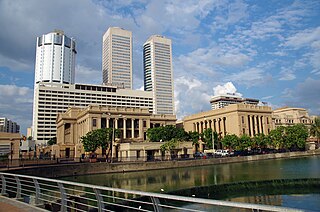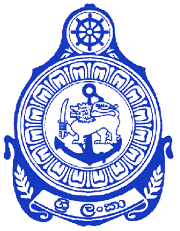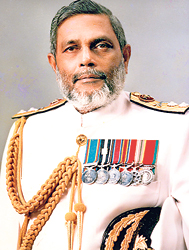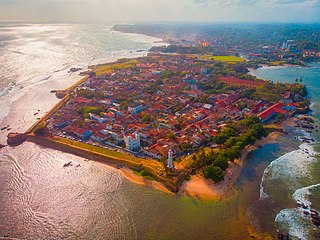
Colombo is the executive and judicial capital and largest city of Sri Lanka by population. According to the Brookings Institution, the Colombo metropolitan area has a population of 5.6 million, and 752,993 in the Municipality. It is the financial centre of the island and a tourist destination. It is located on the west coast of the island and adjacent to the Greater Colombo area which includes Sri Jayawardenepura Kotte, the legislative capital of Sri Lanka, and Dehiwala-Mount Lavinia. Colombo is often referred to as the capital since Sri Jayawardenepura Kotte is itself within the urban/suburban area of Colombo. It is also the administrative capital of the Western Province and the district capital of Colombo District. Colombo is a busy and vibrant city with a mixture of modern life, colonial buildings and monuments.

A 21-gun salute is the most commonly recognized of the customary gun salutes that are performed by the firing of cannons or artillery as a military honor. As naval customs evolved, 21 guns came to be fired for heads of state, or in exceptional circumstances for heads of government, with the number decreasing with the rank of the recipient of the honor. While the 21-gun salute is the most commonly recognized, the number of rounds fired in any given salute will vary depending on the conditions. Circumstances affecting these variations include the particular occasion and, in the case of military and state funerals, the branch of service, and rank of the person to whom honors are being rendered.
After the outbreak of the Second World War, in the British Crown Colony of Ceylon, the government of Sir Don Baron Jayatilaka assured the British King and his government of its continued support.

The Sri Lanka Navy (SLN) is the naval arm of the Sri Lanka Armed Forces and is classed as the country's most vital defence force due to its island geography. It is responsible for the maritime defence of the Sri Lankan nation and its interests. The role of the Sri Lanka Navy is to conduct operations at sea for the defence of the nation and its interests and conduct prompt and sustainable combat operations at sea in accordance with the national policies.

Galle Face Green is a 5 ha ocean-side urban park, which stretches for 500 m (1,600 ft) along the coast, in the heart of Colombo, the financial and business capital of Sri Lanka. The promenade was initially laid out in 1859 by Governor Sir Henry George Ward, although the original Galle Face Green extended over a much larger area than is seen today. The Galle Face Green was initially used for horse racing and as a golf course, but was also used for cricket, polo, football, tennis, and rugby.

Admiral Wannakuwatta Waduge Erwin Clancy Fernando VSV, USP, MNI was a senior Sri Lanka Navy officer. He served as the Commander of the Sri Lanka Navy from 1 November 1991 to 16 November 1992, when he was assassinated by the LTTE he was the most senior officer in the Sri Lankan armed forces to be killed in the line of duty.

The Sri Lanka Artillery (SLA) is the artillery arm of the Sri Lanka Army. It is made up of ten regular regiments and two volunteer regiments. The SLA is headquartered at Panagoda Cantonment, Panagoda.

Ceylon was an independent country in the Commonwealth of Nations from 1948 to 1972, that shared a monarch with other dominions of the Commonwealth. In 1948, the British Colony of Ceylon was granted independence as Ceylon. In 1972, the country became a republic within the Commonwealth, and its name was changed to Sri Lanka.

SLNS Gajabahu was a River-class frigate of the Sri Lanka Navy. She has since been converted to a training ship for the Naval & Maritime Academy, Trincomalee. She was originally HMCS Hallowell of the Royal Canadian Navy, built during the Second World War and then saw service as INS Miznak of the Israeli Navy. The Royal Ceylon Navy purchased her in 1958 from Israel.
HMCyS Vijaya, named in honor of Vijaya, the first king of Sri Lanka, was an Algerine-class minesweeper of the Royal Ceylon Navy, the first warship of that navy. Vijaya had been built as HMS Flying Fish (J370) for the Royal Navy during World War II, but was given to Ceylon by the United Kingdom upon the 1951 formation of Ceylon's navy.
National Day, also known as Independence Day, is a Sri Lankan national holiday celebrated annually on 4 February to commemorate the country’s political independence from British rule in 1948. It is celebrated all over the country through a flag-hoisting ceremony, dances, parades, and performances. Usually, the main celebration takes place in Colombo, where the President of Sri Lanka raises the national flag and delivers a nationally televised speech.
Rear Admiral Rajanathan Kadiragamar, MVO was a Ceylonese flag officer. He was the second Ceylonese Captain of the Royal Ceylon Navy from 1960 to 1970 and as such the longest serving Commander of the Navy.

The Hoods Tower Museum is a naval museum of the Sri Lanka Navy in Trincomalee. It is located at Ostenburg, in the Trincomalee peninsula on a high ridge overlooking the entrance to the inner harbor of Trincomalee within the SLN Dockyard. The museum gains its name from the Hoods Tower, an observation tower named after Vice-Admiral Sir Samuel Hood, Commander of the East Indies Station.
Admiral Deshamanya D. Basil Gunasekara was the Commander of the Sri Lanka Navy from 1973 to 1979.

Fort (Colombo) (Sinhala: කොටුව; Tamil: கோட்டை) is the central business district of Colombo in Sri Lanka. It is the financial district of Colombo and the location of the Colombo Stock Exchange (CSE) and the World Trade Centre of Colombo from which the CSE operates. It is also the location of the Bank of Ceylon headquarters. Along the foreshore of the Fort area is the Galle Face Green Promenade, built in 1859 under the governance of Sir Henry George Ward, the Governor of Ceylon (Sri Lanka) during British colonial era. Fort is also home to the General Post Office, hotels, government departments and offices.

The Port of Colombo Sinhala: කොළඹ වරාය, Tamil: கொழும்பு துறைமுகம் is the largest and busiest port in Sri Lanka and the Indian Ocean. Located in Colombo, on the southwestern shores on the Kelani River, it serves as an important terminal in Asia due to its strategic location in the Indian Ocean. During the 1980s, the port underwent rapid modernization with the installation of cranes, gantries and other modern-day terminal requirements.

Galle Fort, in the Bay of Galle on the southwest coast of Sri Lanka, was built first in 1588 by the Portuguese, then extensively fortified by the Dutch during the 17th century from 1649 onwards. It is a historical, archaeological and architectural heritage monument, which even after more than 432 years maintains a polished appearance, due to extensive reconstruction work done by the Archaeological Department of Sri Lanka.
Sri Lanka Navy (SLN) Dockyard is the largest naval base of the Sri Lanka Navy and a major shipyard located in Trincomalee, Sri Lanka. Established by the British as the Royal Naval Dockyard, Trincomalee, it was home to the East Indies Station of the Royal Navy during World War II. Since the withdrawal of the Royal Navy, the Royal Ceylon Navy took over the dockyard. It became the home base of the RCyN fleet, and today it is home to the Eastern Naval Command and the Naval and Maritime Academy of the Sri Lanka Navy.













